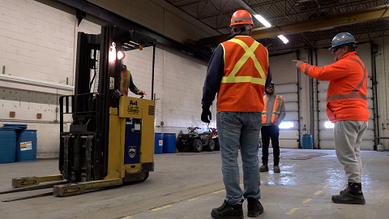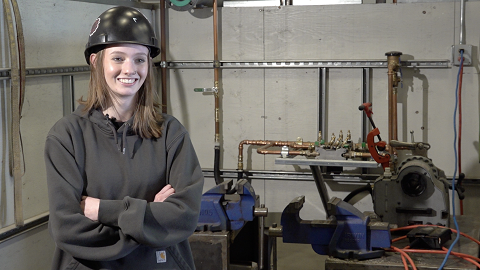|
For a new worker in Saskatchewan, the first days of employment can feel overwhelming.
Though a new career is often a positive experience, those first days can be considered challenging, confusing, or even downright frightening for some. This might be because many new workers feel pressure as they are eager to contribute, be seen as useful, and sense belonging. For these new workers who are enthusiastically looking to prove themselves on their first days, valuable safety information could be missed, as they may often be distracted by trying their best to ‘fit in’ or ‘look the part’.
It is understandable for anyone working in a new professional setting for the first time to deal with fears involving doing the job incorrectly, fitting in socially, or having trouble understanding terms and concepts as they relate to their new work environment. Even for an experienced worker who is now comfortable at their job, learning a new task or responsibility can excite these same feelings. In other words, the prevailing fear that comes with starting a new job might be simply called the ‘jitters’, a fear of ‘messing up’, or ‘letting co-workers down’.
These strong feelings are common and to be expected as new workers begin their jobs in Saskatchewan. However, the significance of these realities is great. New workers struggling with these distractions are at higher risk of missing important training on safe practices, new environments, or dangerous equipment. These distracted, fearful attitudes lend themselves to terrible outcomes, as preventable workplace injuries and fatalities continue to happen to those who are not properly oriented to their new environment.
New workers will have enough personal stress to focus on during their first days on the job, which is why providing safety training early, at the first opportunity, or even prior to starting a new job is not only helpful, but also necessary. Such an early education helps form a foundation of safe thinking that reduces the likelihood of a preventable workplace injury, or worse.
The Saskatchewan Safety Council recognizes that for young people anxious to begin their career in Saskatchewan, a gap in training exists between leaving the education system and entering the workforces. This is why the Council has worked together with several other industry partners to provide a solution. That solution is called Career Safety Education.
“Career Safety Education”, is a completely free online series of workplace safety training programs that build a foundation of knowledge for any new worker by increasing the participants' awareness of hazards and providing a baseline understanding of how to manage the risks present in a broad variety of industries. Career Safety Education continues to grow, as more Saskatchewan organizations recognize and support this program.
As an Employer, recognizing an applicant or a new hire that has completed Career Safety Education is an indication of the value placed on having new workers who have committed themselves to learning safe practices.
As an Educator, encouraging students to participate in Career Safety Education so that they may make a safe transition and entry to the workforce shows that appreciation for this critical stage in a young person's life. As a Parent, recommending Career Safety Education is a clear indicator that safety and awareness are paramount as youth explore possible career paths. Business can show support for the program by becoming a sponsor and advocating for its use.
As Career Safety Education improves and expands, Saskatchewan communities can rest assured knowing quality resources have been put forward to ensure new workers have the resources they need to begin their careers safely.
Explore Career Safety Education: https://www.sasksafety.org/career-safety-education.html Consider Sponsoring the Saskatchewan Safey Council: https://www.sasksafety.org/sponsorship-support-levels.html
Victoria Day Weekend is the official kick-off to a Saskatchewan Summer. Outdoor activities are top of mind this time of year, as Saskatchewanians get out into the wilderness and explore the backcountry. Perhaps you will spend part, or much, of your long weekend behind bars. Hopefully so.
By late May, many riders have already performed their pre-season mechanical inspections but what about those daily or mid-trip pre-ride checks? Who knows what may have changed since you parked your bike beside the tent, outside the hotel, or in the parking lot of your favourite retail stop. A quick walk-around check before jumping back on, regardless of where you are, and a more thorough routine check before each ride, can be the difference between a great ride and one that ends poorly.
Avid Moto-Camper & Motorcycle Instructor David Parker takes us through his routine inspection checklist.
Have anything to ad? Share your must-check inspection items in the comments below! Maybe you have a song you whistle or a pre-ride inspection dance? We'd be happy to hear about it. Free training and resources are made available thanks to contributions from our Donors, Members and Sponsors that believe in our shared goal of creating a province of safety excellence. Want to support content just like this? Play a role in the creation of a province of safety excellence. Donate Today at: www.sasksafety.org/support-us - Charitable Registration Number: 11914-0382-RR
Four crucial tips for getting your riding season off to a safe start:
1. Perform a thorough pre-season inspection of riding gear and your motorcycle. Anything wearing out or torn, lose, leaking, or rusted?... aside from maybe your skills? Perhaps now is a good time to put markers on some key fasteners. Doing so simplifies your mid-season pre-ride inspections if you can walk around and quickly determine if anything has nudged loose. 2. Before going out on the streets, give some consideration to surface conditions. Is there still loose sand and gravel everywhere? Have you been seeing giant potholes on your way to and from the office or grocery store? Make some mental notes. 3. Find a place to practice and re-familiarize yourself with your bike. Especially focusing on slow-speed maneuvers. 4. When you do get out there, leave lots of room between yourself and the person in front of you, thereby avoiding surprise surface changes, and remember, the caged drivers (that's all of us in Saskatchewan in the "off-season", unfortunately) are not used to looking for bikes. Be as visible and as alert as possible. Want to support the creation of content just like this? Donate today at: www.sasksafety.org/donate - charitable registration number: 11914-0382-RR Free training and resources are made available thanks to contributions from our Donors, Members and Sponsors that believe in our shared goal of creating a province of safety excellence. |
Archives
November 2023
Categories
All
|









 RSS Feed
RSS Feed
